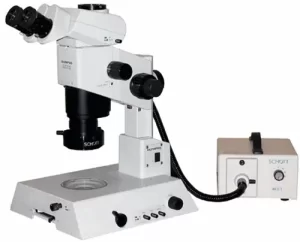Olympus SZX12 / DP50 microscope acquisition P.W. Circuits have invested...
Read MoreENIG & ENEPIG – Two different PCB gold finishes
ENIG - Electroless Nickel Immersion Gold

ENIG is a common surface finish for printed circuit boards (PCBs). This two-layer metallic coating protects exposed copper pads from corrosion. The process ensures a reliable connection for soldering electronic components. First, a layer of nickel is deposited over the copper circuitry. Next, a thin gold layer is plated over the nickel. This gold acts as a protective shield. The nickel layer blocks copper from diffusing into the gold, while the gold keeps the nickel from oxidizing.
ENIG creates a very flat surface. This flatness is important for fine-pitch components like Ball Grid Arrays (BGAs) and Chip-Scale Packages (CSPs). The process improves solder joint precision and reliability. ENIG also offers a long shelf life and excellent solderability.
However, the process needs strict control. Poor plating can cause a “black pad” defect. This defect leads to weak solder joints, making ENIG more complex and costly than some other finishes.
ENEPIG - Electroless Nickel Electroless Palladium Immersion Gold

ENEPIG is an advanced, multi-layered surface finish for PCBs. It adds a palladium layer between the nickel and gold. This creates a robust finish for demanding electronic uses. The palladium is the key difference. It acts as a crucial barrier. This layer stops the “black pad” defect found in some ENIG finishes. This ensures more reliable solder joints.
The palladium layer also offers other benefits. It enhances gold and aluminium wire bonding. ENEPIG provides better corrosion resistance and ensures low contact resistance. The palladium is harder than gold, which improves wear resistance. This finish gives superior solder joint quality.
ENEPIG costs more than ENIG due to extra material and complexity. However, its superior performance makes it ideal for high-density, mission-critical devices. People often call it the “universal finish” because it supports many assembly processes.
Comparison of performance characeristics
| Characteristic | ENIG | ENEPIG |
|---|---|---|
| Reliability | Generally reliable but susceptible to the “black pad” defect, which occurs when the gold corrodes the nickel. This creates brittle, unreliable solder joints. | Highly reliable, as the palladium layer acts as a barrier, preventing the “black pad” defect and ensuring robust solder joint integrity. |
| Versatility | Supports fine-pitch components (like BGAs) and has good solderability for many general-purpose applications. | Also known as the “universal finish” because it is suitable for a wider range of packaging technologies, including wire bonding and multiple reflow soldering cycles. |
| Wire Bonding | Supports aluminum wire bonding but generally has less reliable gold wire bonding capability compared to ENEPIG. | Provides superior and more reliable wire bonding capabilities, especially for gold wire. |
| Solderability | Offers good solderability for standard applications but may degrade over multiple reflow cycles. | Excellent solderability that is maintained even after multiple reflow soldering cycles. |
| Cost | More cost-effective than ENEPIG due to the simpler, two-layer process and the absence of palladium, a precious metal. | More expensive than ENIG because of the added material cost of palladium and the extra processing step. |
When to choose which finish
- Choose ENIG for: Projects where cost is a primary concern and extreme reliability is not essential. It is a proven and effective solution for standard consumer electronics and general-purpose applications that require a flat surface for component mounting.
- Choose ENEPIG for: High-reliability, mission-critical applications where failure is not an option, such as in aerospace, military, and medical devices. It is the better choice for high-density boards, multiple assembly processes, and applications requiring robust wire bonding.
For more information on all our PCB finishes, please visit our dedicated web page or check out our YouTube video.
More PW Circuit posts ...
Protecting Your Intellectual Property in PCB Manufacturing
The Importance of protecting your intellectual property in PCB Manufacturing....
Read MoreWinter Newsletter
Our winter news catch up for PW Circuits for 2019...
Read More

